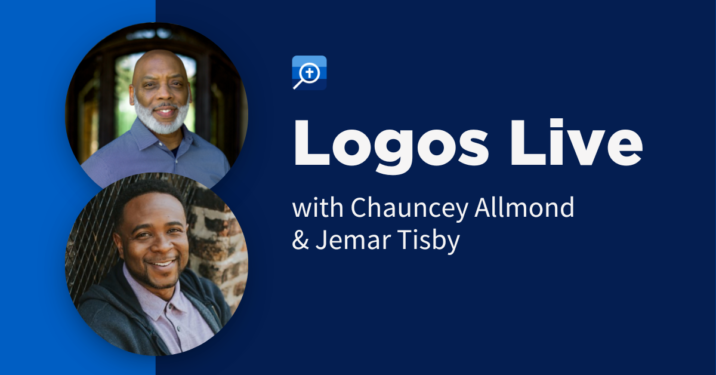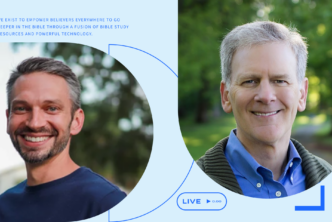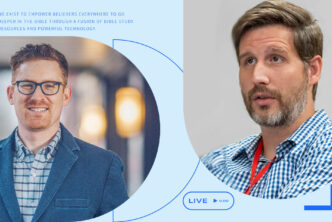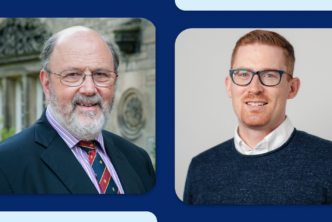What you’ll see in this Logos Live episode
In this episode of Logos Live, we continue our celebration of Black History Month as Chauncey Allmond talks with Jemar Tisby. Jemar Tisby is a New York Times bestselling author, national speaker, and public historian.
To catch all of our Logos Lives, follow us on Facebook or Twitter or subscribe on YouTube.
Books and Audiobooks by Jemar Tisby
Click each image for more information, or add to cart.
The Coming Race Wars: A Cry for Justice, from Civil Rights to Black Lives Matter
Regular price:
How to Fight Racism: Courageous Christianity and the Journey Toward Racial Justice
Regular price:

How to Fight Racism Young Reader’s Edition: A Guide to Standing Up for Racial Justice (audio)
Regular price: $21.99

The Color of Compromise: Audio Lectures: The Truth about the American Church’s Complicity in Racism (audio)
Regular price: $24.99
Interview transcript
This transcript has been lightly edited for readability.
Chauncey Allmond:
Logos Live, we’re with Faithlife, and my name is Chauncey Allmond. I’m a national presenter with FaithLife and I am extremely excited to have brother Jemar Tisby on the line. Jemar, how you doing man?
Jemar Tisby:
I am blessed. I’m doing really, really well. Been looking forward to this conversation.
Chauncey Allmond:
That’s good. Let me get the particulars out the way and give the official bio and all of that’s okay. As you all may know, Jemar is a New York Times bestseller. Best selling author, national speaker, public historian, and he’s on a mission to deliver truths about the black experience with depth and clarity. You can follow Jemar on Facebook, Instagram, Twitter, all the normal social media links and publications. You can also go to his website, which is jemartisby.com, and you also can listen in to the Pass the Mic podcast of which I’m a fan. Brother Jemar, or should I say like Tyler says it, Mr— … how’s it go? Mr. Blue Check Certified himself?
Jemar Tisby:
We don’t need to repeat all that.
Chauncey Allmond:
Yeah. I’m a big fan, man. Even back when you guys were called The Witness and then switched over. That was a couple of years ago you guys switched over to Pass the Mic?
Jemar Tisby:
Yeah, we were called The Reformed African American network, switched over to The Witness of Black Christian Collective and we rocking and rolling.
Chauncey Allmond:
Yeah, man, big fan and it’s great to meet you again. I don’t know if you remember, but in 2019, I was at a conference with Thabiti Anyabwile. It was the Just Gospel conference in Atlanta and had done this Logos presentation. I had my Logos booth out, I saw you come in, and … I don’t know if you knew, but I grabbed you, I grabbed Ekemini (Uwan) and Christina Edmonson and Mika Edmonson. There it is.
Jemar Tisby:
Look at that.
Chauncey Allmond:
There it is.
Jemar Tisby:
Proof.
Chauncey Allmond:
There’s proof.
Jemar Tisby:
You didn’t have a beard back then. Okay.
Chauncey Allmond:
No, no, no. I’m switching over. My wife has me doing this Ronald Isley thing now.
Jemar Tisby:
Oh, it looks good.
Chauncey Allmond:
Thanks man. But yeah, it was an honor to meet you back then as well, and… great to hear you speak and all. What we were hoping to do today is get to know you a little bit better, hear a little bit of Color of Compromise and then your new book, How to Fight Racism. And also maybe … There it is. Look, Jemar, I just added that book to my Logos library yesterday. Haven’t had a chance to read it yet.
Jemar Tisby:
Oh fantastic. Yeah.
Chauncey Allmond:
Yeah. It’s available on Logos and so I got it. I can’t wait to dive in. Want to talk about those two things and whatever else is on your mind. We have about 30 minutes or so, and just want to hear what’s going on, but before we do all that— So man, tell me. What’s going on? What’s keeping you busy these days?
Jemar Tisby:
Oh, brother. I am in such an interesting, exciting, tumultuous time. I actually stepped down from my formal role at The Witness last March. I served for a brief time at the Center for Anti-Racist Research at Boston University. I was working remotely. I stepped down from that on August 5, which is the same day I defended my dissertation, so I remember that date. This season of life has me being a entrepreneur, self-employed as a historian and author and a speaker. I would love for folks to visit my brand new website.
We just relaunched it this past week, jemartisby.com and especially subscribe to my newsletter. That is where you’ll find all my latest work and writing. If you go to jemartisby.com, upper right hand corner, there’s a spot that says newsletter. You can sign up for free, or if you want to support me, you can become a paid subscriber. That’s what I’m doing. I’m working on securing a deal for another book project hopefully soon, and I’ll have more info about that. I’m still doing a good bit of speaking around race and justice. Got some other projects going on that, when they’re further along the line, I can’t wait to share it with y’all.
Chauncey Allmond:
Wow. So you are busy, basically, is what you’re saying. You’re just really busy right now.
Jemar Tisby:
But see, now it’s my own fault. Now I can’t blame anybody.
Chauncey Allmond:
That’s awesome. When we announced this event coming up, a lot of people sent me messages and put some information on Facebook, say, “Hey, we love The Color of Compromise.” I know at my own church, I’m out here in Frisco, Texas, near Dallas. The pastor mentioned that to the congregation. He’s like, “Hey, this is a book you all need to read.” One of the things I liked about the book is that it reads as a history book. The beauty of it, for me personally, was… man, I loved school growing up. High school, college, loved it, and I hated history. I hate to tell you that, but I hated history. When I read your book, even though it read like a historical book, it kept my attention and held my attention. It’s been spreading like wildfire through the circles that I travel in as far as people recommending that book. With all that said, man, of course we want to get to the new one. What was the whole idea behind writing Color of Compromise? What were you setting out to do and accomplish?
Jemar Tisby:
It was a confluence of events. It actually arose, I was just looking back in my journal a couple of weeks ago, it arose out of a presentation that I gave. It was a one off. I came up with this presentation because I was in the midst of my coursework for the PhD. Whatever I was reading, if Christianity came up and if race came up, which it often did, it was white Christians often on the wrong side of justice and I got fired up. I was so upset, so frustrated, so disappointed. I said, “If reading this history makes me feel this way…” It motivated me to want to do more for racial justice. I said, “Maybe other people would have that same feeling.”
But they don’t all have the time or the privilege to sit down and do a PhD in history. I was like, “How can I condense this into a readable form for non-historians, non-academics, for church folk?” The whole goal, actually was—I’ll just let you in on a secret, the whole goal was to get you to chapter 11. First 10 chapters are history and the last chapter is called “The Fierce Urgency of Now.” It’s talking about, “What do we do in light of this racist Christian history?” The whole point was hopefully to use this history as a vehicle to motivate people to anti-racist action today. That was my hope and goal for the book.
Chauncey Allmond:
Wow. It accomplished just that. Again, it was an amazing read. Actually, I’m going through it the second time right now, and you also have a video series that goes along with that. Can you talk about that a little bit?
Jemar Tisby:
I was super thrilled to do the video teaching series. It is available on Amazon Prime Video, as well as some other places like Right Now Media. It goes through the book, but it’s me talking to the camera with visuals, so that’s an added element from the book, and it’s ideal for group study or family study. The episodes are like 20 minutes long, roughly one for each chapter. It’s very digestible and brief, trust me, you don’t want to see me on screen for too long. So we were aware of that, but we’ve gotten tremendous feedback. Folks binge watching it, they might watch it with their families or their church groups. You can go to Amazon Prime Video for that, as well as my second book, How to Fight Racism. There’s a video study for that as well.
Chauncey Allmond:
Yeah. I want to get into that as well. So, just a quick quote from Color of Compromise. I wanted to get your thoughts on it.
Jemar Tisby:
Uh oh.
Chauncey Allmond:
Uh oh. Put him on the spot. In The Color of Compromise, you quote Martin Luther King, Jr. Who said, “There can be no deep disappointment when there is not deep love.” And then you go on to write, “This study is not about discrediting the church or Christians.” You say, “I love the church.” You say, “My concern for the church, and for the wellbeing of its people, motivates my exploration of Christian complicity in racism. The goal is to build up the body of Christ by ‘speaking the truth in love,’ even if that truth comes at the price of pain.” Now, with that quote, can you tell us a little bit about your heart behind your work to serve the church? What motivates you and what do you hope to see as a result of your work?
Jemar Tisby:
Yeah. Brother Chauncey, some folks have said all history is autobiographical, in the sense that what historians choose to study often arises out of their own life experience. The same was true with me where I became a Christian in a white evangelical church context. Race was always part of my religious journey and often in ways where I felt excluded or ostracized in some way shape or form. The book Color of Compromise is hard hitting history. I was using everything I was learning in my doctoral program to do this research, but at the same time, there’s a pastoral element to it. A lot of times, if you’re talking about a subject like racism in the church, there’s a wall that comes down, because people think you’re just bashing the church. You hate Christians.
I don’t do that. It’s for love of the body. It’s for the love of the church that I call out these things like racism and white supremacy, because I want us to be better, and that’s what the Bible talks about. Speaking the truth in love so that the body can grow. I just wanted to make that clear upfront in the book that, this wasn’t coming out of some sort of acerbic cynicism toward the church, this was out of a deep love of the church and a deep disappointment that we hadn’t lived up to our calling as followers of Christ, particularly in the realm of race.
Chauncey Allmond:
Again, that’s awesome. It is having an impact and I’m sure you know that. Book sales are one thing, but to also see the impact that it’s having is huge. If I may kind of integrate your most recent Pass the Mic podcast where you and Tyler got a little vulnerable in terms of talking about some things that were challenging you. If we could, I wanted to touch on that a little bit, but how does Scripture encourage you to keep fighting? Because this is a fight, it’s not going to be an easy fix. It’s not going to be a quick fix. What Scripture do you go to and how does Scripture as a whole encourage you to keep fighting and keep talking, even when you’re discouraged or exhausted? What passages do you find yourself coming back to often?
Jemar Tisby:
I’ve been meditating on Psalm 16. There’s a verse, maybe verse seven, “I have kept the Lord always before me, because he is at my right hand. I shall not be moved.” That is encouraging to me in a time where the landscape is constantly shifting in terms of race relations, and the enemies of racial justice are coming up with new and innovative ways to continue to promote racism and white supremacy. Another passage that is a cornerstone verse for me is from Joshua chapter one, the first nine verses where Joshua is taking over after Moses has died and he always says to Joshua, “Be strong and courageous.” Says it three times in those first nine verses and especially the ninth verse where God attaches a promise to that, says, “Be strong and courageous, not in your own strength, not in your own power, but the promise is for the Lord, your God. I am with you.”
So the promised presence of God, I have felt that so deeply in this racial justice work. That’s my heart and my passion for believers around this. As long as we stay on the sidelines of any sort of justice work, it’s going to seem intimidating and scary, and like, “I can’t do this.” Indeed, that’s always going to be true to a degree, but the payoff is you sense the presence of Christ more deeply, more personally, more intimately than perhaps you ever have. That’s certainly been true in my case, and to be honest, I’m addicted to Jesus. If Jesus says, “In order to get more of me, you got to follow my ways and pursue justice.” Then sign me up.
Chauncey Allmond:
Yeah. Have you had much communication with non–African American pastors? Have they tried to reach out to you and have you had the opportunity, have those one-on-one conversations, to dialogue about what Color of Compromise was all about?
Jemar Tisby:
I’ve gotten a lot of speaking invitations, particularly to Christian colleges and universities, but also churches as well. I’ll be honest, the book came … It dropped in January 2019. It got a new life in 2020 amidst the racial justice uprising, and I think the book came at a moment when people were, particularly because of the 45th president and all that revealed about white evangelicalism, re-evaluating their faith communities, their theological traditions. The Color of Compromise scratched that itch to learn more about it. However, that is only a beginning. What I long for, is for people to continue on this path of racial justice, and so what I find is, after the book study, after watching the videos, people know more, but they don’t necessarily do more.
Chauncey Allmond:
Mm.
Jemar Tisby:
They go back to their old ways. They try to fix the age old problem of racism in the church, and it’s still very white centered in a way. They’re still listening to white people’s voices. They’ll use our books or our resources to help the lights come on, but then they won’t continue to access the wisdom, the knowledge, the genius, say, of black church tradition, which arose in direct response to white supremacy. I long for more white Christians to follow the leadership of marginalized people who have been dealing with this stuff for generations.
Chauncey Allmond:
Yeah. Did that springboard to your new book, How to Fight Racism? If so, can you talk about that transition from Color of Compromise into How to Fight Racism, the book, and how that came about?
Jemar Tisby:
Yeah. The most frequent question I get whenever I speak about racial justice is, “What do we do?” It always comes in some way, shape, or form, and I actually like that question because it says, number one, “We know racism is still a problem.” And we can’t take that for granted nowadays that people understand that. There’s a lot of people who think racism somehow went away when Rosa Parks refused to stand up, and when LBJ signed the Civil Rights Act in 1964. It’s still here. It’s still being promulgated among young people. There’s no aging out of racism. There’s no generation that can die off that’s going to eliminate this thing. I appreciate the fact that folks still realize it’s a problem. The second thing, that question, “What do we do?” communicates is, “I want to be part of the solution.” But what I found was, even in my own work, I was heavy on the diagnosis, light on the prescription.
Heavy on describing the problem, relatively light on what to do about it. Even then, as I looked across the literature, when people did address it, which was proportionally a lot less than describing the problem, even when they did address it, it was hard to follow. It would be a bullet point list of suggestions at the end of the chapter, or one chapter with this sort of breadth of different ideas, and that’s hard to keep in your head, let alone put into practice. What I think is the real value of my second book, How to Fight Racism, is not just the practical suggestions, of which there are plenty, but it’s the framework.
The arc of racial justice that stands for awareness, relationships, commitment, awareness, relationships. That gives us a grid and a framework and approach to racial justice, so that we can do all kinds of different actions that build our awareness, that build intentional relationships, that build our commitment. Not just changing our individual attitudes, but changing laws, policies, practices, and systems that create and perpetuate racial inequality. How to Fight Racism is my book-length answer to that, “What do we do?” question.
Chauncey Allmond:
Yeah. One of the things that you mentioned in How to Fight Racism is how essential it is to share stories. That’s essential to moving forward, and I know … There you go. In my own experiences, I’ve found where people, non–African American people, who want to ask the right questions, they want to get involved, they want to do things, but they feel concerned that their questions may come across as racist or they don’t feel like they have safe spaces to dialogue. Some may not have a group of African American friends, or at church, if they go to a predominantly white church, there’s not that go to family or those go to families to be able to express that. With that said though, how do you think pastors and small group leaders and everyday Christians too, create safe environments in which people can share their stories without fear of retribution? What do you think that could look like?
Jemar Tisby:
We live in the information age and the digital age. One of my favorite answers to that question of, “What do we do? How do we learn?” is just two words long. Google it. I mean, you can learn a lot from a simple internet search about why white people shouldn’t say the N word. Why would you want to say the N word if you’re white? That’s been in the news lately with a certain podcaster on Spotify. I think a lot of those basic questions of like, “What if I say the wrong thing?” You can research a lot of that on your own without ever risking an encounter in a face to face or personal relationship like that.
That being said, there is still value in white folks getting together and talking about race. You may not have the knowledge and perspective of a person of color in that group, but you can access our content and our work, whether it’s through the books, or the video study, or some other source. There are going to be some among that group who probably are further along in the journey than others. That creates a safe environment, especially for white folks who are afraid to bring this up with black folks, which honestly is valid because we’re tired.
We have to explain this stuff day in and day out on top of actually living it. I’m still devastated by the killing, in many ways, a murder, of Amir Locke in Minneapolis. Yet another no knock, forced entry, in the midnight hour, and the entire encounter was less than 10 seconds. Do you realize the implications of that? I used to say, “The moment Black people step out the door, we are under threat.” But the reality is, even in our own homes, not even leaving the door, we are under threat. We live with that day to day reality, and it is helpful if white folks do some of the work. I mean, my work is trying to be helpful to folks who don’t know as much. There are folks out there, like yourself I imagine as well, who are willing to have the conversations, if it’s in good faith. To me, that’s what really matters. I don’t mind if somebody says something wrong or unwittingly makes a misstep if they’re humble enough to really want to learn and not just out there trolling or trying to start an argument.
Chauncey Allmond:
Yeah. What I want to get into now is, in our last few minutes, for those people who are wanting to get information, they’re wanting to learn more. They may not have those folks at church or in their communities that they can talk to, want to talk about ways that we can get them information. Like you said, “Google it.” I love that. “Google it.”
In addition to that, I’ll just throw out a plug for, I don’t have a book to hold up, but I will plug logos.com/kerusso. I don’t know if you’ve heard about that, but that’s our initiative that we have going on, where we have several African American pastors and preachers and teachers who are on this council or a committee that are working with Faithlife to ensure that the resources that are in the Logos library are more reflective of African American scholars, theologians, etc. It’s logos.com/kerusso. We want to point people who want more information, go there. You can purchase resources. Again, we’re in the information age. There is no excuse now for people not saying, “I don’t know where to go.” That’s one site I’ll give people. I want to look at podcasts for a minute, because I know podcasts are huge. We know we want people to go to Pass the Mic, but what are some other podcasts that you listen to and other podcasts that you would recommend for people who want to get involved more, learn more, learn more about the African American experience? What are a couple of recommendations that you might have for someone?
Jemar Tisby:
For sure Truth’s Table. Black Christian sisters. They call themselves mothers of the church in training. They tackle everything, and by the way, they’ve got a book coming out, I believe in April, called Truth’s Table that everyone should pre-order. Pre-order really helps authors. That’s one that I frequently listen to. Other than that, I tune into different churches. As we talk about, “How can folks learn?” You can visit six different churches in one day without ever leaving your chair. Now, Because of this pandemonium that we’re still in, a lot of churches have extended their services online. My co-host Tyler Burns is a phenomenal preacher. He’s at All Nations Worship Assembly, Pensacola. He has some wonderful words of encouragement. The spouse of one of the hosts of Truth’s Table is the pastor at Koinonia Church in Nashville. Put into those Progressive Baptist Church with Charlie Dates. Black Millennial Cafe, it has some great resources with sister Brianna Parker, Jude 3 Project with Lisa Fields, doing phenomenal work there. There’s a small but powerful contingent of Black Christians doing really innovative digital forward work in the space of race and justice and faith.
Chauncey Allmond:
Yeah. I was going to conclude our time together by saying, “Hey, if you could identify one thing that a pastor or church leader could do to keep the momentum going or get the momentum started if they haven’t yet?” And I think you’ve hit that and we’ve hit that. Visit different churches. My church just recently read a book that’s called, Weep with Those Who Weep, and I don’t know if you agree with that book, but one of the things that it encouraged non–African American churches to do were to do things like that, but it went one step further. It was, “Go visit an African American church. Go to the African American Museum in DC to see what it’s like. I think we kind of hit that next step, ’cause I wanted to-
Jemar Tisby:
The one thing I’ll add is, because we tend to, in our Western mindset, we tend to always emphasize building awareness and knowledge. We use the arc of racial justice to make sure we have, not necessarily a balance, but a holistic approach to racial justice. Build your awareness, but also, I would encourage churches and individuals, in terms of relationship, to partner in some way, shape, or form with justice organizations. Also, on the commitment level, I’ve got to say this. As we record this, there was a new report released about the role of Christian nationalism in the January 6 insurrection. Christian nationalism is the biggest threat to the witness of the church today, and I mean that it is an existential threat to democracy as we know it. All churches, Black, white, Latinx, Asian. All Christians should be aware of informing themselves and equipping themselves to fight against Christian nationalism. If you go to my socials, there’s a link to that report, and we’ve got to inform ourselves because this is the crisis. This is the front against which we are battling in, what I call, the modern day Civil Rights Movement.
Chauncey Allmond:
Yeah. Well, Jemar, thank you for your time, man. I wish we could go on for more, but I don’t want to get in trouble at Faithlife. You stay close to my time, but it’s been great speaking with you and you’re leading the charge and I would encourage you to keep doing what you’re doing, man. It’s needed work out there and we appreciate it. I personally appreciate it and I’m sure others do as well. Thank you for your time and, to sign off, maybe you can just give again your Instagram or your webpage, however people can get in contact with you.
Jemar Tisby:
Well, first of all, I appreciate you. Thank you so much for this time to share with your audience. If folks want to follow me, as my partner in crime Tyler says, “Follow at your own risk.” It is @JemarTisby on Twitter, and Instagram and Facebook, @JemarTisby1. I’ll do one last plug, we are starting an online book study for my latest book, How to Fight Racism, the young reader’s edition. Kids eight and up are invited. The first one is this Thursday at 7:00 p.m. Central Time. You can find more info at my newsletter.
Chauncey Allmond:
We will do it. I will go there myself today and get signed up and hope everyone listening to this will do the same. Brother Jemar, thank you again. It’s been a pleasure. Look forward to maybe doing some things with you again in the future.
Jemar Tisby:
Let’s do it.
Chauncey Allmond:
All right. Okay. Thank you guys. This has been a great time talking with Jemar Tisby. Again, my name is Chauncey Allmond. This is Logos Live. Tune in next week and the week after, we have some exciting guests coming up. Next, I’ll have Trillia Newbell, and after that, I’ll have Dr. Eric Mason coming up. Man, you will not want to miss what we have in store at Logos Live. Thank you. Enjoy the rest of your day. Jemar, we’ll talk to you next time.
Jemar Tisby:
Peace.
Chauncey Allmond:
All right. Take care.






